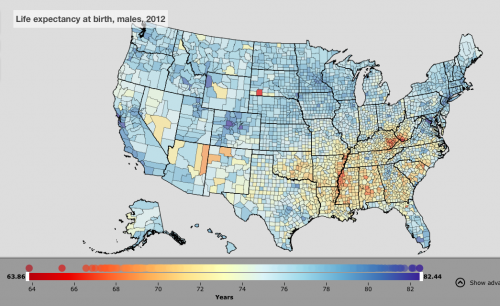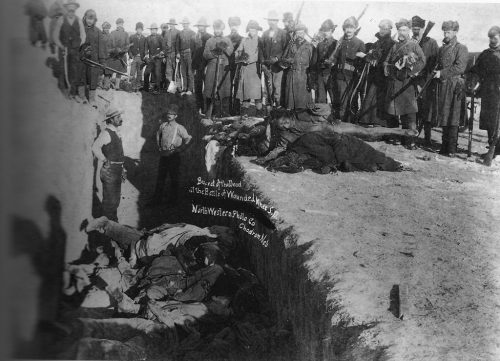Here is a map of male life expectancy at birth by US county. Your eye is drawn to the striking red patch on the border of South Dakota and Nebraska. It has a history.

That’s Oglala Lakota County, which falls entirely within the Pine Ridge Reservation of the Oglala Lakota nation. This is the poorest county in America, with $8,768 per capita income. Male infants there have a life expectancy of 65.2 years, compared to 76.5 for the US as a whole. This is less than the (male and female) life expectancy in Laos and Yemen. Oglala Lakota County experienced 1945 deaths per 100,000 population in 2013 (compared to 927 / 100,000 for the US as a whole).
The people of Oglala Lakota County are, clearly, exposed to severely adverse social determinants of health. But this epidemiological language is too impersonal: the social determinants include a history of oppression and murder. The Wounded Knee Massacre of Lakotas by the US 7th Cavalry occurred here in 1890.

Many communities have terrible histories. Oglala Lakota County is only the second worst country in the US for male life expectancy. The worst (3142 out of 3142) is McDowell County, West Virginia, where male infants are expected to live only 63.9 years. This is slightly worse than the life expectancy at birth in the Sudan. McDowell County was once a leading coal-producing county, but the industry has since collapsed. In 2015, the county had the highest rate of opioid deaths in the US (141 deaths per 100,000 people, roughly 10 times the rate for the US as a whole).
In light of the 2016 election, there have been many scholarly and popular accounts of the health crises of rural US whites. These concerns are entirely appropriate. But we need to register the health needs of all communities, not just the ones that swing elections.

